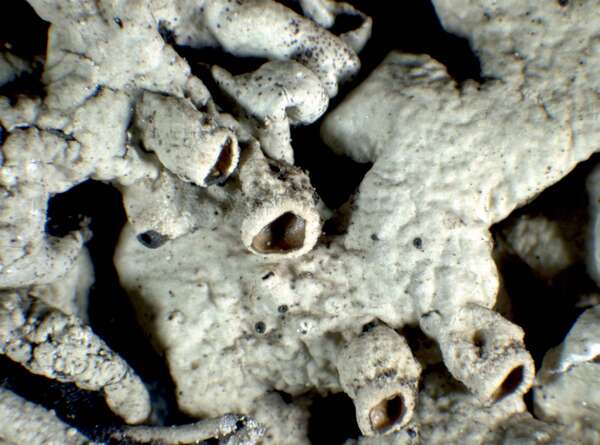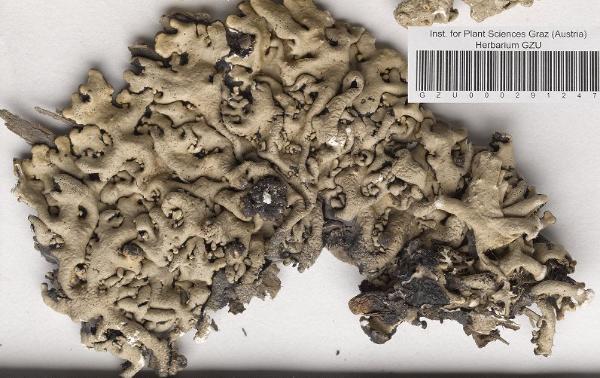Hypogymnia laminisorediata D. Hawksw. & Poelt
in Hawksworth, Lichenologist, 5: 253, 1973.
Synonyms:
Distribution: S - Cal (Puntillo 1996).
Description: Thallus foliose, heteromerous, dorsiventral, rather loosely attached, forming 4-12 cm wide, regular or irregular rosettes, the lobes swollen, hollow inside, 2-6 mm wide, sometimes with lateral, much smaller lobules. Upper surface grey to grey green, dull, sometimes with a brownish hue especially in peripheral parts, strongly folded in central parts, with diffuse to pustulate soredia originating from the folds; lower surface jet black, except in the brown marginal parts, rugose, erhizinate. Upper cortex of tightly packed, more or less anticlinally oriented hyphae, the cell walls with Cetraria-type lichenan; medulla soon becoming hollow, lining the cavity inside the lobes; lower cortex dark, paraplectenchymatous. Apothecia lecanorine, 5-17 mm across, stipitate, the stipes 3-9 mm high, with a brown, imperforate, concave to convex, often cracked disc and a smooth, persistent thalline margin. Epithecium brown; hymenium colourless, 25-35 μm high; paraphyses coherent, simple or sparingly branched in upper part, 2-3 μm thick; hypothecium colourless. Asci 8-spored, clavate, Lecanora-type. Ascospores 1-celled, hyaline, ellipsoid, 4.5-7 x 2.5-5.5 μm. Pycnidia black, immersed. Conidia cylindrical, 4-7 x 1-1.5 μm. Photobiont chlorococcoid. Spot tests: upper cortex K+ yellow, C-, KC+, P- or P+ faintly yellow, UV-; medulla K-, C-, KC+ orange-red, P-. Chemistry: upper cortex with atranorin and chloroatranorin; medulla with physodic acid and 2 unknown compounds.Note: a species of the Mediterranean mountains, also known from Morocco, Macaronesia, Serbia and Turkey, found on acid bark in humid montane forests.
Growth form: Foliose, narrow lobed
Substrata: bark
Photobiont: green algae other than Trentepohlia
Reproductive strategy: mainly asexual, by soredia, or soredia-like structures (e.g. blastidia)
Most common in areas with a humid-warm climate (e.g. most of Tyrrenian Italy)
Commonnes-rarity: (info)
Alpine belt: absent
Subalpine belt: absent
Oromediterranean belt: absent
Montane belt: extremely rare
Submediterranean belt: absent
Padanian area: absent
Humid submediterranean belt: absent
Humid mediterranean belt: absent
Dry mediterranean belt: absent

Predictive model
Herbarium samples
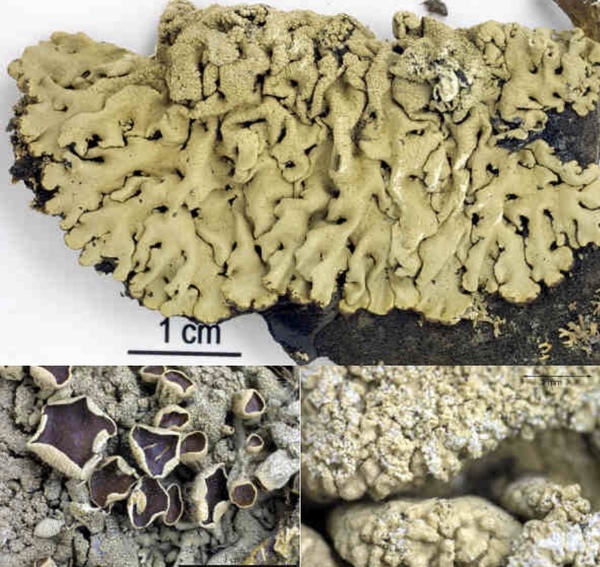

Felix Schumm – CC BY-SA 4.0
Image from: F. Schumm (2008) - Flechten Madeiras, der Kanaren und Azoren. Beck, OHG - ISBN: 978-3-00-023700-3
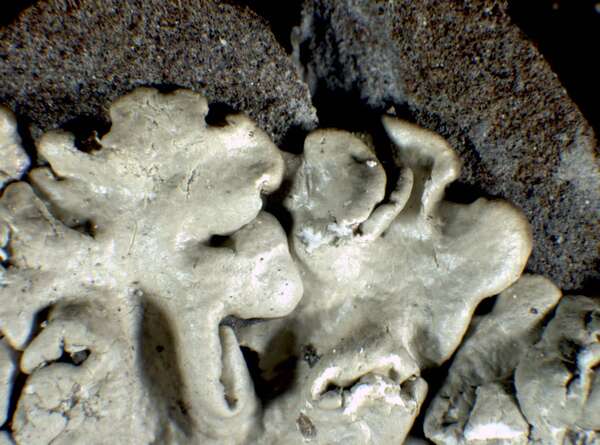

P.L. Nimis; Owner: Department of Life Sciences, University of Trieste
Herbarium: TSB (31534)
2001/11/23
marginal lobes
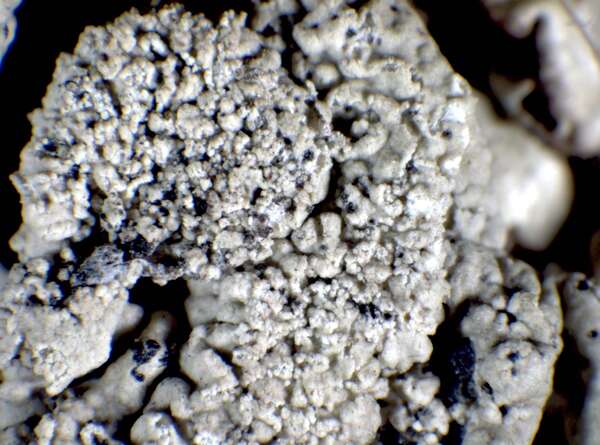

P.L. Nimis; Owner: Department of Life Sciences, University of Trieste
Herbarium: TSB (31534)
2001/11/23
detail of soredia
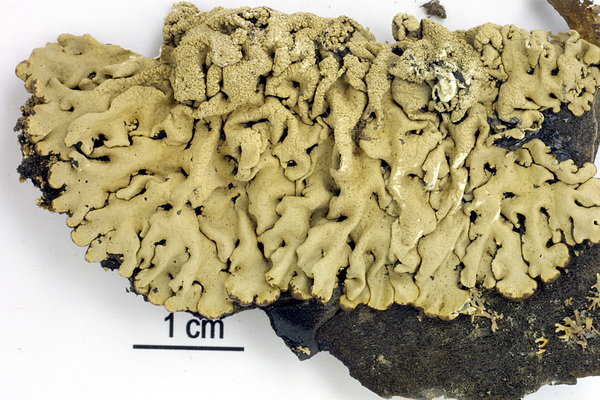

Felix Schumm - CC BY-SA 4.0
[12152], Türkei: Prov. Mugla, 37°38' N, 27°42' E, 850 m, Pinus brutia am Paß über den Besparmakdag bei Milas. Leg. V. John 25.03.1983, det. V. John. Ex Herbario Volker John Nr. 5512.
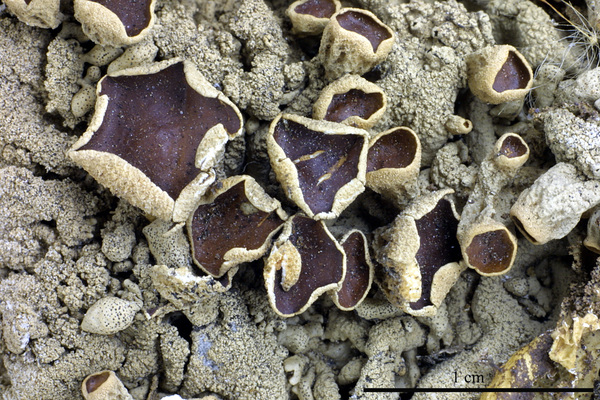

Felix Schumm - CC BY-SA 4.0
[12152], Türkei: Prov. Mugla, 37°38' N, 27°42' E, 850 m, Pinus brutia am Paß über den Besparmakdag bei Milas. Leg. V. John 25.03.1983, det. V. John. Ex Herbario Volker John Nr. 5512.


Felix Schumm - CC BY-SA 4.0
[12152], Türkei: Prov. Mugla, 37°38' N, 27°42' E, 850 m, Pinus brutia am Paß über den Besparmakdag bei Milas. Leg. V. John 25.03.1983, det. V. John. Ex Herbario Volker John Nr. 5512.
Growth form: Foliose, narrow lobed
Substrata: bark
Photobiont: green algae other than Trentepohlia
Reproductive strategy: mainly asexual, by soredia, or soredia-like structures (e.g. blastidia)
Most common in areas with a humid-warm climate (e.g. most of Tyrrenian Italy)
Commonnes-rarity: (info)
Alpine belt: absent
Subalpine belt: absent
Oromediterranean belt: absent
Montane belt: extremely rare
Submediterranean belt: absent
Padanian area: absent
Humid submediterranean belt: absent
Humid mediterranean belt: absent
Dry mediterranean belt: absent

Predictive model
| Herbarium samples |


Felix Schumm – CC BY-SA 4.0
Image from: F. Schumm (2008) - Flechten Madeiras, der Kanaren und Azoren. Beck, OHG - ISBN: 978-3-00-023700-3


P.L. Nimis; Owner: Department of Life Sciences, University of Trieste
Herbarium: TSB (31534)
2001/11/23
marginal lobes


P.L. Nimis; Owner: Department of Life Sciences, University of Trieste
Herbarium: TSB (31534)
2001/11/23
detail of soredia


Felix Schumm - CC BY-SA 4.0
[12152], Türkei: Prov. Mugla, 37°38' N, 27°42' E, 850 m, Pinus brutia am Paß über den Besparmakdag bei Milas. Leg. V. John 25.03.1983, det. V. John. Ex Herbario Volker John Nr. 5512.


Felix Schumm - CC BY-SA 4.0
[12152], Türkei: Prov. Mugla, 37°38' N, 27°42' E, 850 m, Pinus brutia am Paß über den Besparmakdag bei Milas. Leg. V. John 25.03.1983, det. V. John. Ex Herbario Volker John Nr. 5512.


 INDEX FUNGORUM
INDEX FUNGORUM
 GBIF
GBIF
